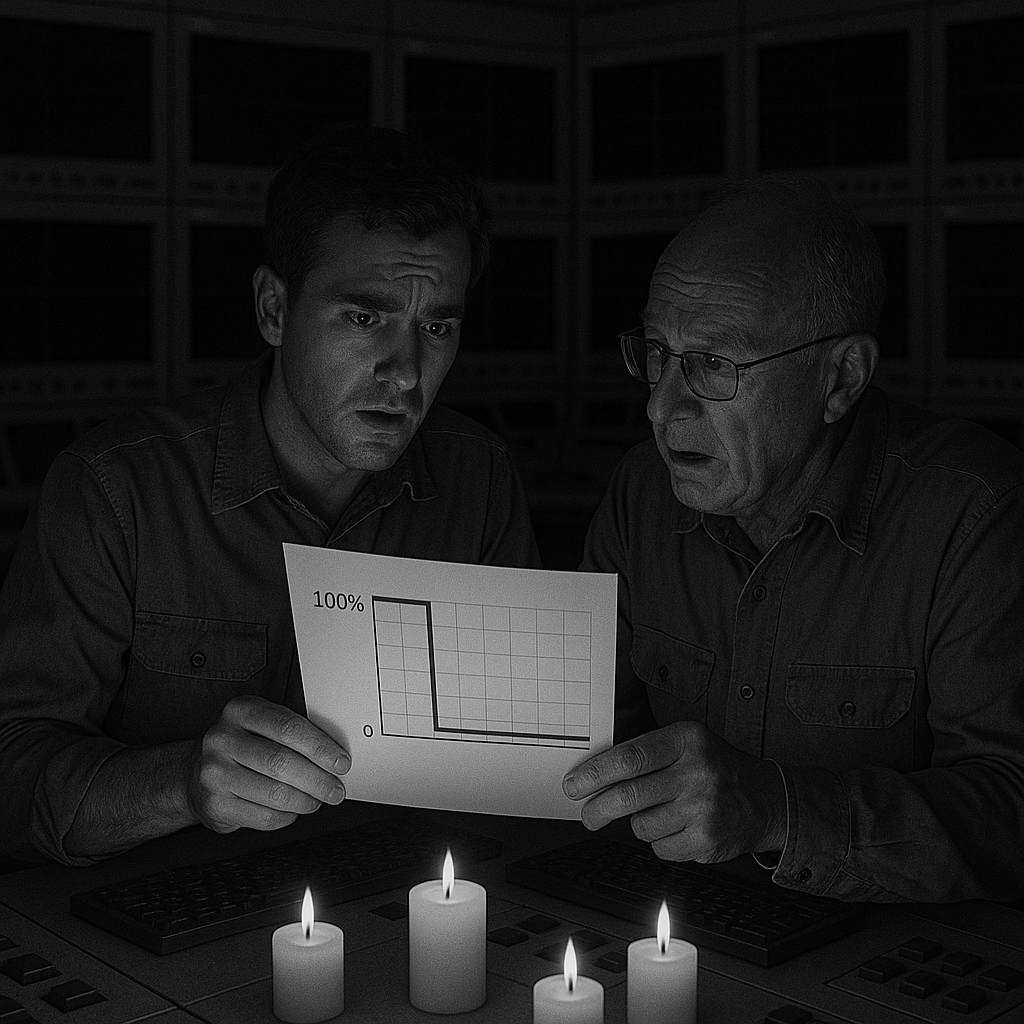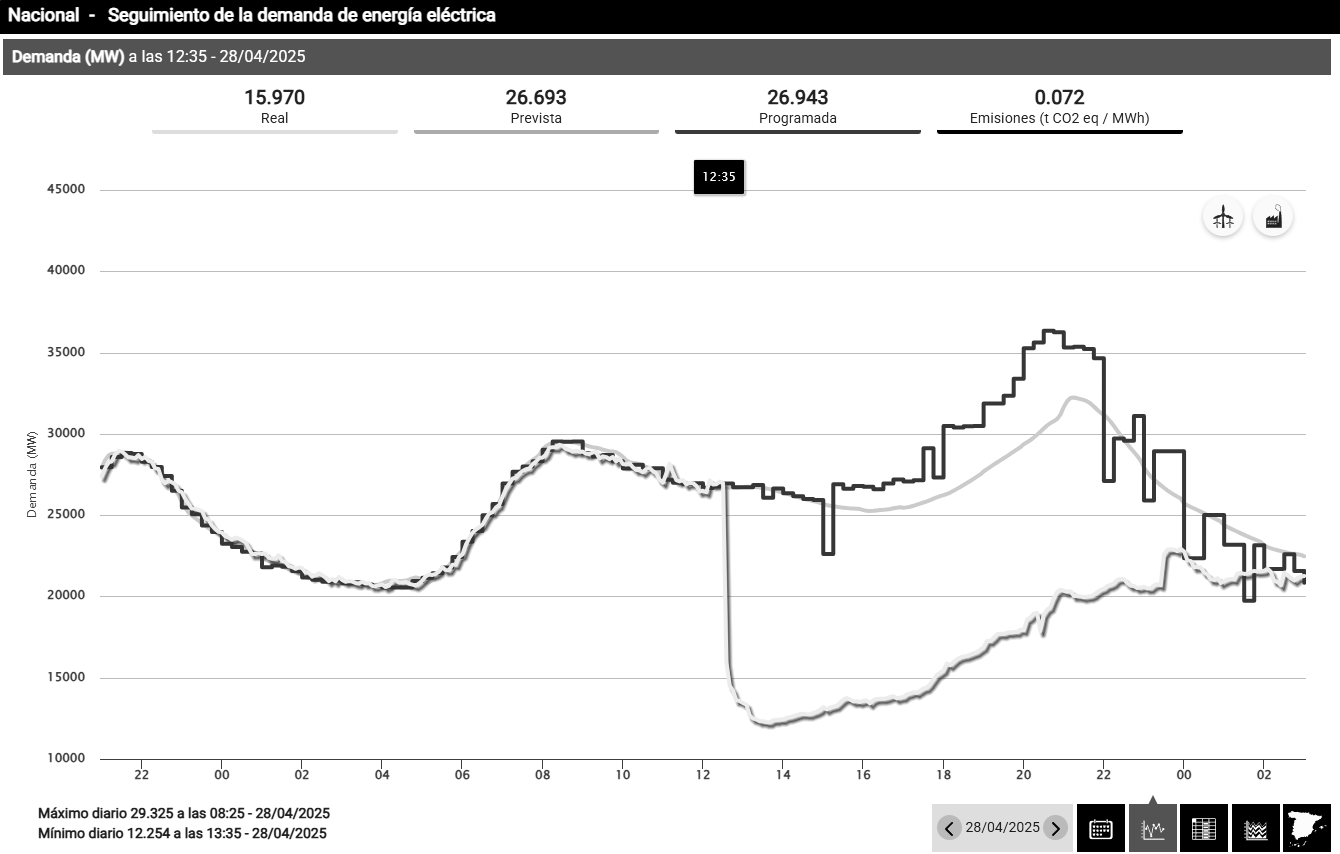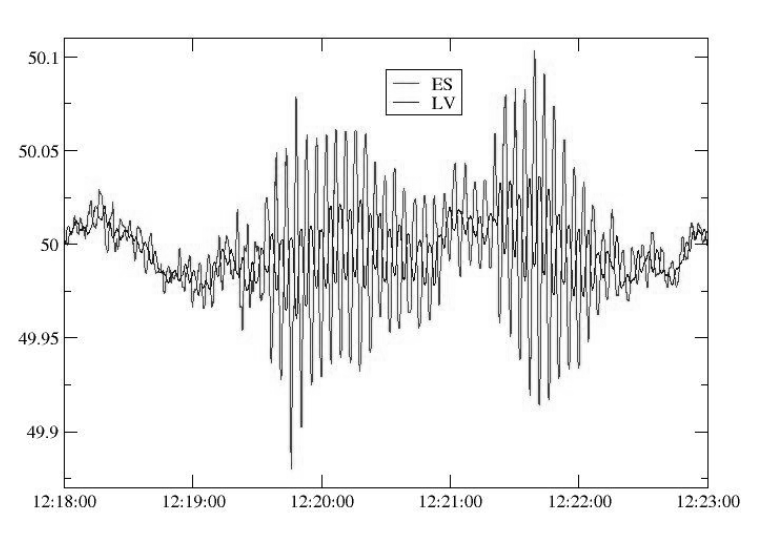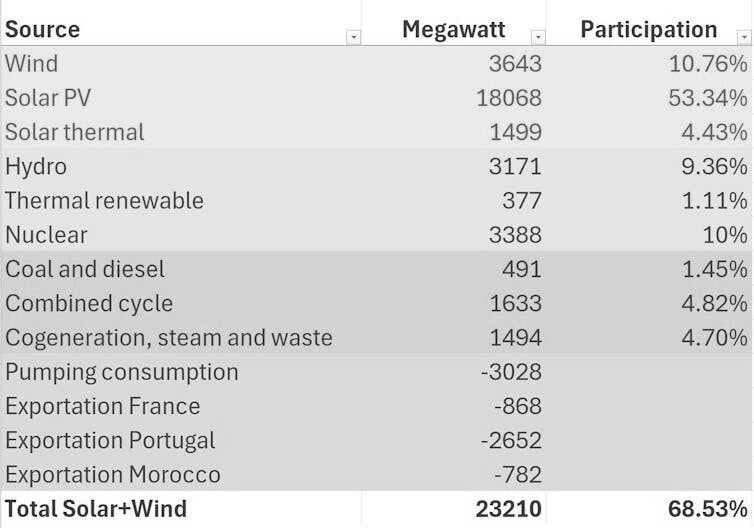
The electricity collapse in Spain and Portugal reignites the debate on the energy trilemma between sustainability, security and accessibility: a technical and political challenge for the EU of the future.
The power outage that sent almost the entire Iberian Peninsula into darkness on 28 April 2025 laid bare the vulnerabilities of European electricity grids in the midst of the energy transition. As investigations into the causes and responsibilities of the disaster proceed, questions arise about the geopolitical risks linked to the growing interdependence between EU countries and external energy suppliers. The blackout has focused attention on the fragility of a system that, while aiming at decarbonisation, still appears exposed to external shocks, infrastructure shortcomings and international tensions.
At midday, Spain and Portugal remain in the dark
At 12.33pm on Monday, 28 April 2025, the Iberian Peninsula suddenly switched off. In less than five seconds, some 15 gigawatts of generating capacity – over 60 per cent of Spain’s electricity needs at that instant – disappeared from the grid. Suddenly, millions of people were stranded, traffic lights out of action, public transport on the blink, ATMs switched off, telephones silent, television and radio stations cut off, the Internet unreachable.
It is the largest blackout ever recorded in Europe, and days later the causes still remain unknown. By late Tuesday morning, almost the entire electricity supply had been restored, but the central questions – what triggered the collapse and why – remain unanswered.
The official technical investigation has been entrusted to ENTSO-E, the European Network of Electricity System Operators, which – according to EU Regulations 714/2009 and 2017/1485 – will have to coordinate the analysis with all operators involved. But the process will be long: a first preliminary report is expected in Brussels within six months, while the final report will not arrive before September 2026.
Meanwhile, the absence of certainty fuelled a wave of speculation and controversy. Some media, without waiting for official feedback, immediately blamed renewable energies, Net Zero targets and, more generally, the energy transition. Above all, the high share of photovoltaics in the Spanish electricity mix ended up in the crosshairs, accused – without proof – of making the system too fragile in the face of unforeseen events.
In five seconds, the largest blackout in the history of Europe
The event will be remembered as the most serious blackout in the history of our continent. Millions of people in Spain and Portugal were suddenly without electricity, also affecting the Principality of Andorra and the Basque region of France. An almost total, sudden and extensive outage has knocked out infrastructure, communications and transport.
At a press conference, Red Eléctrica – the Spanish grid operator – reconstructed the sequence of events: a few seconds after 12:33 a.m., an initial anomaly occurred on the grid, a loss of power in the generation plants. The system initially held up and seemed to stabilise. But just one and a half seconds later, a new event tipped the balance. After another 3.5 seconds, the connection between Catalonia and south-west France was automatically switched off for safety reasons. From there on, the system failed: a massive and simultaneous loss of power overwhelmed the entire power grid.
The blackout spread like an out-of-control domino effect, causing a cascading collapse. Red Eléctrica spoke of an ‘unexplained disappearance’ of 60% of national production. Prime Minister Pedro Sánchez, who spoke a few hours later, acknowledged the gravity of the situation: ‘This has never happened before. And what caused it is something that experts have not yet established – but they will’.
The sudden loss of 15 GW in Spain is visible in the official electricity generation diagrams. At the same time, another 5 GW suddenly disappeared from Portugal’s power grid.

The system cashed in on the first blow, but went down on the second. When the power grid was knocked out, only a small portion of the Iberian Peninsula remained powered. For almost 60 million people in Spain, Portugal, Andorra and part of southern France, Monday afternoon turned into a sudden nightmare.
Total paralysis, but within hours the peninsula was back on its feet
The blackout struck deep, paralysing vital infrastructure and silencing the daily lives of millions. Telecommunications collapsed, roads and railways came to a standstill, airports ground to a halt, and shops and offices were forced to close. Only hospitals were able to continue functioning, thanks to emergency generators – mostly powered by diesel. In many cities, hundreds of thousands of people took to the streets, forced to make long journeys home on foot, with subways and trains at a standstill everywhere.
The crisis also had an immediate impact on mobility. Between 30,000 and 35,000 people were evacuated by stranded train convoys, often in the underground tunnels of subways. Telephone and Internet networks were completely down. In Portugal, the authorities ordered the precautionary evacuation of schools and the closure of banks, while ATMs were unusable. Supplies were bought in supermarkets, but only in cash: transactions were noted down by hand on sheets of paper, like in the good old days.
The response of the institutions was swift. The Spanish Ministry of the Interior proclaimed a state of emergency, mobilising 30,000 agents to guarantee public order. Extraordinary councils of ministers were convened in Spain and Portugal, and on Tuesday morning King Felipe VI chaired a meeting of the National Security Council, officially starting an in-depth investigation.
Despite the extent of the crisis, the restoration times were astonishing. By 10pm on Monday, 421 of the 680 electrical substations in Spain had already been reactivated, covering 43% of demand. Red Eléctrica later reported that, by Tuesday morning, over 99% of supply had been restored. In Portugal, the operator REN announced the complete return to normal as early as 23:30 on Monday. Both operators were praised by ENTSO-E for the speed and effectiveness of the intervention.
What caused the blackout?
In the day after the blackout, a collective rush to find explanations began. Politicians, technicians, journalists and ordinary citizens launched themselves into hypotheses and conjectures, often in the absence of certain data. Prime Minister Pedro Sánchez stated that the government did not yet have conclusive information, but assured that ‘no hypothesis is excluded’.
Red Eléctrica, however, ruled out a number of leads from the outset: no cyber attacks, no human error, and no major weather anomalies. “There has been no intrusion into the control systems,” specified the head of the operational service, ruling out cyber-attack scenarios for the time being.
The investigation initiated at the instigation of the government will involve theNational Cybersecurity Agency (INCIBE) and the National Intelligence Centre (CNI), which will collect information directly from the network operators and energy companies involved.
Meanwhile, some media reconstructions blamed an alleged phenomenon called ‘induced atmospheric vibration‘ – a term absent from the technical lexicon of power grids, which seems to refer to oscillations in the atmosphere due to sudden changes in temperature or pressure. But according to weather reports, the weather was perfectly stable at the time of the blackout.
More credible is the lead related to a deviation of the electrical frequency from the canonical 50 Hz. Excessive oscillation can in fact activate automatic protection systems, leading to the immediate shutdown of entire grid segments to avoid greater damage. Some technicians noted that, shortly before the blackout, abnormal fluctuations were indeed recorded, similar to those that occurred – curiously enough – also in Latvia, on the other side of the interconnected European ENTSO-E network … and the entire continent.

A graph circulated by Philippe Jacquod, professor of electrical engineering at the universities of Geneva and Western Switzerland (HES-SO Valais-Wallis), and relayed by Professor Lion Hirth of the Hertie School in Berlin, reveals a disturbing detail: a few minutes before the blackout, the grid frequency in Spain began to fluctuate noticeably – around 0.15 Hz, with an amplitude of 200 millihertz. What was most surprising was the perfect synchronisation with data recorded in Latvia, more than 3,000 kilometres away, suggesting the existence of a continent-wide anomaly.
It is evident that, only a few minutes before the catastrophic blackout, something triggered this oscillation, which seems to be unprecedented.
Why haven’t the nuclear plants intervened?
Another question that remained unanswered immediately concerns the role – or rather, the absence – of nuclear power. Why did the Spanish reactors fail to plug the sudden drop in production?
Spain currently has seven nuclear reactors. On the day of the blackout, however, three of them – those of Santa María de Garoña, Trillo and José Cabrera – were already shut down for economic reasons. Exceptional production from solar sources had drastically lowered electricity prices, making it uneconomic to keep them running. According to the regulations, at least two reactors must nevertheless remain operational to guarantee grid security.
However, the four active plants – Vandellós II and Almaraz I and one of the two reactors in Ascó, – were operating at 50 per cent of their capacity, due to photovoltaic overproduction. When the grid began to destabilise, the control systems detected frequency and voltage fluctuations above the safety thresholds. Self-protection was therefore triggered: the reactors automatically shut down to prevent damage to the equipment.
All nuclear power plants followed the required safety protocols and were secured without any risk to the population. The emergency diesel generators ensured the operation of critical internal systems, averting any immediate danger. But their failure to contribute to balancing the grid at crucial moments opened another front for reflection on the reliability and coordination of the national energy mix.
What about hydroelectric power plants?
At the time of the blackout, the price of electricity on the Spanish wholesale market was negative: about -1 euro per megawatt hour. A paradoxical condition that pushed Spain to export energy not only to Portugal and Morocco, but even to highly nuclear-powered France. With supply far exceeding demand, the surplus energy was used for hydroelectric pumping: a mechanism that consists of lifting water from lower basins to mountain basins to store it as a reserve of potential energy.
However, even this strategy has its limitations. With their reservoirs now full, the hydroelectric power stations were no longer able to continue storing energy, and were therefore partially shut down. At that crucial moment, the national electricity system found itself without its most reliable sources: the hydroelectric plants were at full capacity, the gas-fired power stations were not ready to intervene, and the renewable sources, by their nature intermittent, could not guarantee continuity.
Thus, at 12:33, the Spanish grid stood on an extremely fragile balance. The energy mix appeared almost 70% unbalanced on zero-emission sources – but not programmable by nature – lacking sufficient rapid response capacity and without adequate backup resources that could be activated in real time. What could possibly go wrong?

All the fault of Renewables? No, but…
While the official investigation is still ongoing, an increasing amount of attention has been focused on the high share of renewable energy in the Spanish grid. The Madrid government’s ambitious goal is well known: to reach 81% renewable production by 2030 and 100% by 2050. On 16 April, just a week before the blackout, Spain had celebrated a historic milestone: for the first time, the entire national electricity demand had been met exclusively by renewable sources – with wind covering 46%, solar 27%, hydro 23%, and the rest distributed between solar thermal and other strictly green sources.
According to some reconstructions, the first alarm signal may have come from Extremadura, a region with a very high energy concentration – where the Almaraz plant is located, which with a capacity of 2 GW is the most powerful nuclear power plant in the country, alongside vast hydroelectric plants and a widespread network of photovoltaic parks. Red Eléctrica admitted that ‘it is very likely that the generation shares involved in the first events came from solar’.
This has rekindled the debate, which has never died down, on the stability of grids powered largely by renewables, characterised by production that is by definition discontinuous. The far-right party VOX took the opportunity to attack the government’s energy policy, arguing for a more ‘balanced’, i.e. fossil-based, mix. But many experts were quick to warn against easy conclusions.
“The blackout cannot be attributed to a single source,” said European Energy Commissioner Dan Jørgensen. “On that day, the system was powered by completely regular sources. There was nothing abnormal.”
And indeed, unforeseen events – such as the sudden disconnection of a photovoltaic plant or a localised blackout – are already covered in the security protocols of modern grids. Suffice it to say that the simultaneous loss recorded on the day of the blackout – between 15 and 20 gigawatts – is equivalent to twelve to fifteen large gas or nuclear power plants, or more than a hundred solar parks. This is therefore not a localised anomaly, but a systemic collapse.
Redeia Corporación, the holding company of Red Eléctrica, firmly rejected the idea that renewables were responsible, also adding that ‘the interruption was not due to human error’. Ecological Transition Minister Sara Aagesen also spoke out in defence of the ecological transition: ‘The system has handled similar situations before. Blaming renewables in this case is simply inappropriate’. The minister also promised that her department will conduct an independent and thorough investigation into the causes of the disaster.
There had been a warning, but no one had noticed it
Meanwhile, new elements emerge from the ongoing investigation. 5 May. More than a week after the accident, Sara Aagesen stated in an interview with the public broadcaster TVE that the Spanish high-voltage power grid suffered more interruptions in power generation than initially known.
“We have new information: there was a third generation loss” that occurred 19 seconds before the blackout, Aagesen said, pointing out that this was in addition to the two already identified in the first minutes after the event. ‘We are trying to identify the plants’ where the generation collapse occurred and understand the causes, the minister added. Until then, the government had reported two main events: the first production collapse at a plant located in south-west Spain, followed by a second one, 1.5 seconds later, in the same area. The emergence of a third, even earlier anomaly further complicates the picture and confirms that the 28 April event had a more complex dynamic than initially assumed.

The inertia and fragility of a network under stress
The blackout that paralysed the Iberian Peninsula has brought a well-known but often neglected issue back to the centre of the debate: the fragility of electrical systems with high renewable penetration. The technical community has long been aware of the risks associated with the lack of ancillary services, particularly those related to frequency regulation and system inertia, which are fundamental to grid stability.
Traditionally, these services are provided by large conventional plants – nuclear, thermoelectric or hydroelectric – which, thanks to their rotating masses, offer a buffer against sudden fluctuations. In fact, the rotating turbines, mechanically connected to the generators, act as flywheels: they cycle at the same frequency as the grid (50 Hz, i.e. fifty cycles per second) and provide the ‘electrical inertia’ needed to absorb any shocks and gain valuable reaction seconds.
But, with the energy transition, this inertia is breaking down. Modern renewables, such as solar photovoltaics and wind power, are not mechanically connected to the grid: they operate via grid-following inverters, which merely synchronise with the existing grid, without contributing to its stability. Without a robust conventional base, the system becomes more vulnerable to disturbances. And on 28 April came the clearest proof of this.
In the minutes before the blackout, Spanish production was dominated by photovoltaics, while conventional power plants – including nuclear reactors – operated at reduced power. This drastically reduced the available inertia. When a significant part of the generation suddenly disconnected, the grid did not have the capacity to absorb the blow: a chain reaction of automatic disconnections, system protections and finally … general collapse set in.
Some analysts have identified precisely the lack of inertia as one of the main causes of the crisis. But this is a partial reading. Sources capable of providing inertia – such as nuclear, hydroelectric and solar thermal – were in any case present and operational at the time of the accident. Red Eléctrica had also introduced dedicated devices, such as synchronous condensers, to increase artificial inertia and improve the dynamic response of the grid.
It is likely that a higher level of inertia would have dampened the frequency fluctuations that were observed. But to say that it would have avoided the blackout altogether is conjecture, not data. The truth is that the Spanish network, like many others in Europe, is in a complex transition phase in which traditional tools and new technologies must coexist. There are alternative solutions: devices such as flywheels (mechanical flywheels) can provide inertia in a sustainable and non-fossil fuel dependent way. But they require time, planning and structural investment.
A lesson for the energy transition
During the energy crisis triggered by the sanctions against Russia, some conservative media did not hesitate to point to the green transition as an indirect cause of the weakening of European electricity grids. Yet, the experience of Spain and Portugal over the past decade tells a very different story: the expansion of solar and wind power has reduced greenhouse gas emissions, lowered energy costs and strengthened independence from imported fossil fuels.
However, current renewable energy technology, however advanced, is not yet able to guarantee the stability of electricity systems on its own. What is needed is synchronised reserve power – provided by hydro, nuclear or gas plants – capable of compensating for the intermittency of non-programmable sources. In other words, it is not enough to produce clean energy: one must also be ready to intervene when the wind stops or the sun disappears. And this requires newly designed grids, capable of managing the unstable balance between abundance and scarcity.
The energy transition was born with an idealistic and necessary drive, focused on environmental sustainability and promoted since the 2000s by global environmental movements. But in recent years, with the war in Ukraine and the ensuing shock in the energy markets, the complexity of the energy trilemma has emerged forcefully: environmental sustainability, security of supply and universal access to energy. Three objectives that are often in tension with each other.
With Trump’s return to the White House and the subsequent reversal of US energy policies, the pendulum seems to have swung towards energy security. And now, with the blackout that has put the Iberian Peninsula in the dark for hours, the risk is that the balance between the three pillars will be lost.
The 28 April blackout does not justify an indiscriminate return to fossil fuels. But it represents a clear warning: the energy transition cannot only be a matter of decarbonisation. It is also, and increasingly so, a technical, infrastructural and political challenge that requires a balance between innovation and resilience. Reducing emissions is indispensable, but not enough: we need to ensure continuity of service, grid reliability, and security of supply. It is not a question of choosing between clean energy and stability, but of building a system capable of offering both. And the real test will not be the absence of incidents, but the ability to deal with them without losing direction. Only by tackling this structural node will it be possible to ensure a sustainable, secure energy transition that serves everyone.
















